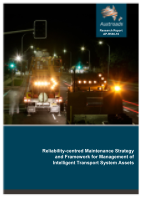Asset Management

- Publication no: AP-R536-16
- ISBN: 978-1-925451-52-8
- Published: 13 December 2016
- PDF (free) Download
This report provides a reliability-centred maintenance (RCM) strategy and framework to manage intelligent transport system (ITS) assets.
ITS assets play a key role optimising efficiency and minimising crash risk in modern road network operations. ITS devices, however, fail frequently and every time they fail, the device can either be unavailable or operating in a degraded state for a long time. Unscheduled maintenance is costly and faults can potentially occur during critical times when the ITS asset is required to be functioning as designed/intended causing avoidable congestion cost and an increase in the risk of an incident.
RCM is the application of engineering principles to manage the consequences of failure under a constrained maintenance budget. The use of RCM was raised in Austroads project AT1534 in 2013 as a potential approach to dealing with the issue of ITS failures under constrained maintenance budgets.
The report covers the identification of key success factors, confirmation of the benefits and acceptability of RCM within jurisdictions including their contractors and suppliers, design of an RCM process template, and drafting of a road map for moving from the current practice to RCM.
- Summary
- 1. Introduction
- 1.1. Project Objectives
- 1.2. Scope of the Project
- 1.3. Overview of the Report
- 2. Key Issues
- 2.1. Role of ITS Assets
- 2.2. Failure of ITS Assets
- 2.2.1. Impact of ITS Asset Failure
- 2.2.2. Scale and Profile of ITS Asset Failure
- 2.2.3. Profile of ITS Asset Failure
- 2.3. Current ITS Asset Maintenance Practice
- 2.3.1. Maintenance and Renewal of Traffic Signals
- 2.3.2. Maintenance and Renewal of VMS
- 2.3.3. Certification, Testing and Commissioning
- 2.4. Discussion
- 3. RCM Process and Application
- 3.1. Background on RCM
- 3.2. RCM Process
- 3.3. Review of RCM Applications
- 3.4. Enabling RCM Practice
- 3.5. Analytics and Performance Benchmarking
- 3.6. Discussion
- 4. Application of RCM to ITS Assets
- 4.1. Review of ITS Asset Faults and RCM Tasks
- 4.1.1. Traffic Signals – Pole Fails to Protect against Moisture Ingress and Condensation
- 4.1.2. Traffic Signals – Unable to Detect Pedestrians
- 4.1.3. Traffic Signals – Unable to Detect Vehicles
- 4.1.4. VMS – Multiple Pixel Faults
- 4.1.5. VMS – Communication Fault
- 4.1.6. VMS – Failure of Structural Support
- 4.2. Views on the Adoption of RCM for ITS Assets
- 4.2.1. Benefits and Outcomes of RCM
- 4.2.2. Perceived Gaps in the Practice of RCM
- 5. Road Map for Implementing RCM
- 5.1. Purpose of the Road Map
- 5.2. Gaps in the Application of RCM
- 5.3. Road Map Tasks
- 5.4. Measuring Road Map Progress
- Theme 1: Gaps in the enabling organisational and contractual environment
- Theme 2: Gaps in performance analytics and benchmarking
- Theme 3: Gaps in the understanding of ITS asset functional failure consequences vs network performance targets
- Theme 4: Gaps in cross-jurisdictional knowledge sharing
- 6. Conclusions and Recommendations
- References
- Appendix A Seven-step RCM Process
- A.1 Overview
- A.2 Step 1: Functions
- A.3 Step 2: Functional Failures
- A.4 Step 3: Failure Modes
- A.5 Step 4: Failure Effects
- A.6 Step 5: Failure Consequences
- A.7 Step 6: Proactive Maintenance
- A.8 Step 7: Other Options (also known as Default Strategies)
- Appendix B RCM Applications in Australian Infrastructure Sector
- B.1 Case Study 1 – RCM for Rail
- B.1.1 Introduction
- B.1.2 Planning and Preparation
- B.1.3 Analysis
- B.1.4 Implementation and Results
- B.1.5 Sustain
- B.1.6 Benefits of RCM
- B.2 Case Study 2 – Sydney Water
- B.2.1 Application Timeline
- B.2.2 Business Owner – Asset Owner – Delivery Partners Model
- B.2.3 Asset Management System
- B.2.4 Stakeholder Consultation
- B.2.5 Benchmarking Tool
- Appendix C RCM Workshops
- C.1 Purpose of the Workshops
- C.2 Application of the RCM Process
- C.3 Workshop Outputs
- C.3.1 Traffic Signals – Pole Fails to Protect Against Ingress and Condensation
- C.3.2 Traffic Signals – Unable to Detect Pedestrians
- C.3.3 Traffic Signals – Unable to Detect Vehicles
- C.3.4 VMS – Multiple Pixel Faults
- C.3.5 VMS – Communication Fault
- C.3.6 VMS – Failure of Structural Support
